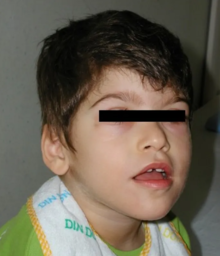Pitt–Hopkins syndrome
| Pitt–Hopkins syndrome | |
|---|---|
 | |
| Boy with Pitt–Hopkins syndrome showing the characteristic facial features. | |
| Specialty | Psychiatry, Medical genetics |
Pitt–Hopkins syndrome (PTHS) is a rare genetic disorder characterized by
As more is learned about Pitt–Hopkins, the developmental spectrum of the disorder is widening, and can also include difficulties with
PTHS has traditionally been associated with severe
PTHS is estimated to occur in 1:11,000 to 1:41,000 people.[7]
Signs and symptoms
PTHS can be seen as early as childhood.[8]
The earliest signs in infants is the lower face and the high nasal root.[7]
The facial features are characteristic.[9]

Adults who have PTHS may have trouble with their speech.[8] Craniofacial features, which are important when diagnosing PTHS, become more visible as the person gets older.[7]
Genetics
The genetic cause of this disorder was described in 2007.[10] This disorder is due to a haploinsufficiency of the transcription factor 4 (TCF4) gene which is located on the long arm of chromosome 18 (18q21.2) The mutational spectrum appears to be 40% point mutations, 30% small deletions/insertions and 30% deletions. All appear to be de novo mutations. The risk in siblings is low, but higher than the general population due to parental germline mosaicism.[7]
A Pitt–Hopkins-like phenotype has been assigned to autosomal recessive mutations of the contactin associated protein like 2 (CNTNAP2) gene on the long arm of chromosome 7 (7q33-q36) and the neurexin 1 alpha (NRXN1) gene on the short arm of chromosome 2 (2p16.3).[11]
Malformations in the CNS can be seen in about 60 to 70% of patients on MRI scans.[12]
Pitt–Hopkins patients with a TCF4 deletion can lack the syndrome's characteristic facial features.[7]
Diagnosis
There is not a certain diagnostic criteria, but there are a few symptoms that support a diagnosis of PTHS. Some examples are: facial dysmorphism, early onset global developmental delay, moderate to severe intellectual disability, breathing abnormalities, and a lack of other major congenital abnormalities.[8]
Zollino and colleagues defined diagnostic criteria based on characteristic features found in 75% of cases genetically confirmed for PTHS, termed cardinal features. If a person shows 9 cardinal features, they are classified as having PTHS.[13]
It is possible that a phenotype resembling PTHS can occur without the mutation in the TCF4 gene. Mutations in the TCF4 gene do not always result in stereotypical Pitt-Hopkins syndrome. [13]
Half of the individuals with PTHS are reported to have seizures, starting from childhood to the late teens.[7]
Around 50% of those affected show abnormalities on brain imaging. These include a hypoplastic
According to the clinical diagnosis. PTHS is in the same group as Pervasive Developmental Disorders.[14]
When a patient is suspected of having PTHS, genetic tests looking at the TCF4 gene are typically done.[7] Some argue for a genetic test to occur first, followed by a clinical assessment. [15]
Differential diagnosis
PTHS is symptomatically similar to Angelman syndrome, Rett syndrome and Mowat–Wilson syndrome.[12]
Angelman syndrome most closely resembles PTHS. Both have absent speech and a "happy" disposition. Of the differentials, Rett syndrome is the least close to PTHS. This syndrome is seen as a progressive encephalopathy. Both Angelman syndrome and Rett syndrome lack the distinctive facial features of PTHS. Mowat–Wilson syndrome is seen in early infancy and is characterized by distinctive facial abnormalities.[12]
Treatment
There is no specific treatment for this condition. It is based on symptomatology. Since there is a lack of treatment, people with PTHS use behavioral and training approaches.[14]
Recommendations for developmental delay and intellectual disability in the U.S. (may differ depending on country):[7]
- Early intervention program from newborn to age 3 will allow access to different therapies (occupational, physical, speech, and feeding).
- Developmental preschool through public school systems from ages 3 to 5. The child will need an evaluation before getting into the program, to see what kind of therapy is needed.
- From the ages 5–21 the child's school may create an IEP (based on the child's functions and needs). Children are encouraged to stay in school until at least the age of 21.
History

The condition was first described in 1978, by D. Pitt and I. Hopkins (The Children's Cottages Training Centre, Kew and Royal Children's Hospital, Melbourne, Australia) in two unrelated patients.[16]
References
- PMID 17436255.
- ^ PMID 31586495.
- S2CID 9559486.
- ^ "Pitt-Hopkins syndrome may point the way to autism treatments". Daniel R. Weinberger. May 2019.
- ^ "Pitt-Hopkins". National Center for Biotechnology Information. Retrieved 8 December 2009.
- ^ "A drug for autism? Potential treatment for Pitt-Hopkins syndrome offers clues; PTHS". The Conversation. 26 April 2019. Retrieved 10 July 2019.
- ^ PMID 22934316.
- ^ PMID 28520343. Bookshelf ID: NBK66129.
- S2CID 161843893. Retrieved 16 October 2022.
- PMID 17436254.
- PMID 22670138.
- ^ PMID 27617128.
- ^ PMID 30677142.
- ^ PMID 23640545.
- PMID 29318938.
- S2CID 45629810.
